Sunshine Factory, Co., Ltd. > Applications > ZrP for PolymerZrP for Polymer
Enhanced Mechanical Properties of Nylon6 Nanocomposites Containing Pristine a-Zirconium Phosphateby Melt-Compounding
Enhanced mechanical properties of Nylon6 nanocomposites containing pristine a-zirconium phosphate by melt-compounding
It have been fabricated by a simple and direct melt-compounding method without adding intercalation or exfoliation agents.
Owing to the excellent compatibility between the nanofillers and Nylon6, the pristine ZrP nanoplatelet nanocrystallites were well dispersed and homogeneously distributed into the polymer matrices during the melt processing, but still maintained their original layered state as observed by scanning electron microscopy and X-ray diffraction.
Tensile testing and dynamic mechanical analysis on the Nylon6/ZrP nanocomposites illustrate that the size and concentration of the pristine ZrP nanoplatelets have a profound effect on the mechanical properties of such prepared polymer nanocomposites.
The improvement of the mechanical reinforcement for the Nylon6 nanocomposites does not show a steady increase with the increase in the size and concentration of the embedded pristine ZrP nanoplatelets, but displays the maximum for the pristine ZrP nanoplatelets with a size ranging from 600 nm to 800 nm at a concentration of _3.0–5.0% in the polymer matrices.
The mechanisms that are responsible for the mechanical reinforcement of thermoplastic polymer matrices by the embedded pristine ZrP nanoplatelets, as well as their comparisons with corresponding epoxy nanocomposites, are also discussed.
1.Introduction
Polymer nanocomposites containing well-dispersed inorganic nanofillers exhibit significantly reinforced mechanical performance and excellent physical properties. ZrP nanoplateletshave shown great potentials on improving the flame retardant properties of various thermoplastic matrices,
2. Experimental
Preparation of Nylon6 nanocomposite containing ZrP nanoplatelets.
According to proportions listed in Table 1,
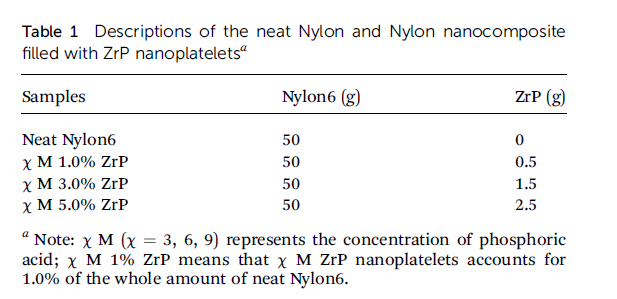 3. Results and discussion
3. Results and discussion
3.1. Characterizations of ZrP nanoplatelets and Nylon6 nanocomposites

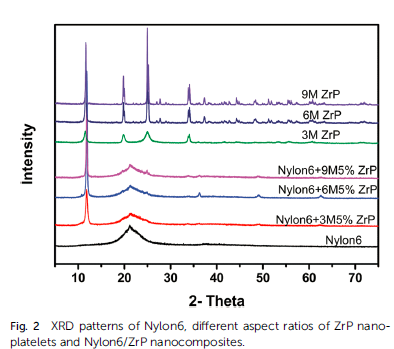 3.2. Mechanical properties
3.2. Mechanical properties
3.2.1. Tensile testing
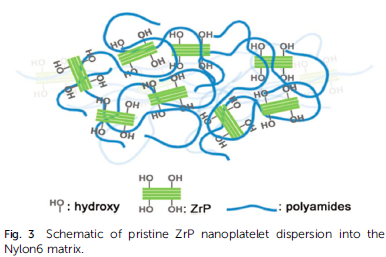
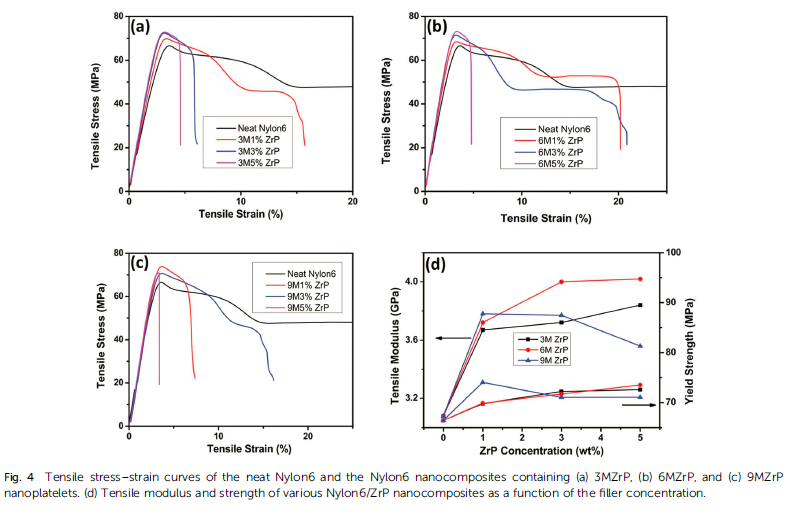
It is clear from the tensile results that with the incorporation of pristine ZrP nanoplatelets, Nylon6/ZrP nanocomposites show a considerable enhancement in tensile modulus and a limited increase in tensile strength along with a reduction in elongation at break as compared to the neat Nylon6, which is mainly due to the presence of inorganic nanoplatelets as reinforcing fillers.
3.2.2. Dynamical mechanical analysis.

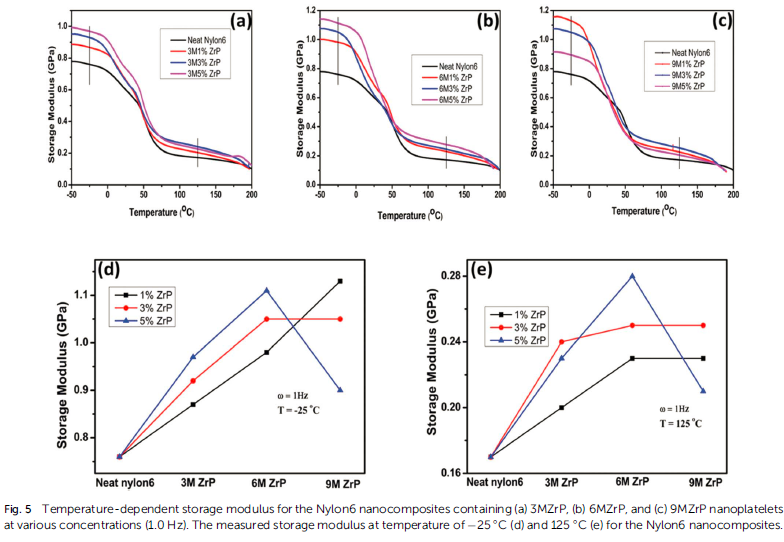
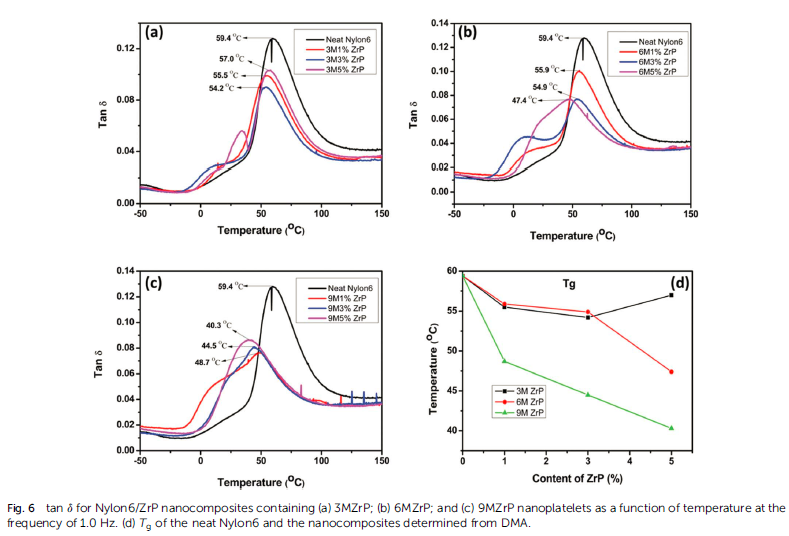
Compared with the neat Nylon6, the storage modulus of the nanocomposites undergoes a significant improvement owing to the incorporation of the nanoplatelets into the polymer matrices, indicating that pristine ZrP nanoplatelets embedded have a strong reinforcing impact on the dynamic elastic behavior of Nylon6.
4. Conclusion
The size of the ZrP nanoplatelets ranging from 200 nm to 2 µm.
It have been fabricated by a simple and direct melt-compounding method without adding intercalation or exfoliation agents.
Owing to the excellent compatibility between the nanofillers and Nylon6, the pristine ZrP nanoplatelet nanocrystallites were well dispersed and homogeneously distributed into the polymer matrices during the melt processing, but still maintained their original layered state as observed by scanning electron microscopy and X-ray diffraction.
Tensile testing and dynamic mechanical analysis on the Nylon6/ZrP nanocomposites illustrate that the size and concentration of the pristine ZrP nanoplatelets have a profound effect on the mechanical properties of such prepared polymer nanocomposites.
The improvement of the mechanical reinforcement for the Nylon6 nanocomposites does not show a steady increase with the increase in the size and concentration of the embedded pristine ZrP nanoplatelets, but displays the maximum for the pristine ZrP nanoplatelets with a size ranging from 600 nm to 800 nm at a concentration of _3.0–5.0% in the polymer matrices.
The mechanisms that are responsible for the mechanical reinforcement of thermoplastic polymer matrices by the embedded pristine ZrP nanoplatelets, as well as their comparisons with corresponding epoxy nanocomposites, are also discussed.
1.Introduction
Polymer nanocomposites containing well-dispersed inorganic nanofillers exhibit significantly reinforced mechanical performance and excellent physical properties. ZrP nanoplateletshave shown great potentials on improving the flame retardant properties of various thermoplastic matrices,
2. Experimental
Preparation of Nylon6 nanocomposite containing ZrP nanoplatelets.
According to proportions listed in Table 1,

3.1. Characterizations of ZrP nanoplatelets and Nylon6 nanocomposites


3.2.1. Tensile testing


3.2.2. Dynamical mechanical analysis.



4. Conclusion
The size of the ZrP nanoplatelets ranging from 200 nm to 2 µm.

Follow WeChat


